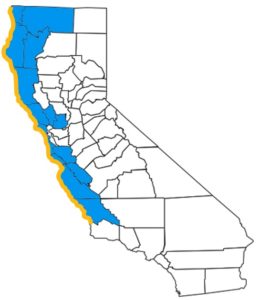Thanks in part to Sustainable Conservation, in 2013 clean water and imperiled fish in California got a boost from the California Coastal Commission. The agency, which oversees land use along California’s more than 1,000-mile coastline, unanimously approved a region-wide program to speed the implementation of voluntary habitat restoration projects in coastal areas. Its decision was greatly influenced by the success of our Simplified Permitting for Restoration program.
Accelerating Restoration

The yellow line represents the extent of the consistency determination’s effect, while the areas shaded blue indicate the jurisdiction of the California Coastal Commission, which the consistency determination covers.
The Coastal Commission’s decision benefits California’s coastal zone from the Oregon border through San Luis Obispo County, and eliminates the need for landowners to obtain individual Coastal Development permits from cities, counties or the Coastal Commission when working with the National Oceanic and Atmospheric Administration’s (NOAA) Restoration Center to restore habitat. The ruling applies to restoration projects on both private and public lands coordinated through the NOAA Restoration Center.
As a result, projects that modify or remove barriers to fish passage, increase stream shading and return denuded streams to a more thickly wooded condition, reduce sediment runoff, increase water conservation and other restoration activities will be more easily planned and implemented.
What the Experts Say
Charles Lester, Executive Director of the Coastal Commission, stated that the agency’s action is a practical step to support restoration of critical coastal resources such as stream corridors and coastal wetlands that fish and other wildlife depend on for survival. “NOAA is a leading conservation partner, and its restoration program gives landowners, community organizations and public agencies the opportunity to work together for the benefit of our coastal areas. This decision will encourage more projects that improve habitat and stream flows in the coastal zone.”
“This is a great confirmation from the Coastal Commission that our restoration work benefits a variety of important coastal resources, and that improving fish habitat is a shared goal,” said Patrick Rutten, Southwest Region Supervisor for the NOAA Restoration Center, which took the initiative to gain Coastal Commission approval for accelerated permitting. “We appreciate the partnership between state and federal agencies this decision represents.”
Because the NOAA Restoration Center will still require all restoration projects it oversees to meet strict environmental protection requirements, the Coastal Commission’s approval does not reduce any environmental safeguards or assurances.
The Problem
The precipitous decline of salmon and steelhead populations in California is linked directly to the modification and destruction of their stream and estuary habitats, and degraded water quality. Loss of native stream vegetation, increased stream temperatures and sediment levels, and excessive diversion of summer stream flows are key threats to these iconic fish species that have inhabited coastal California for thousands of years.
Many coastal landowners want to restore their land and the waterways that flow through their properties, including re-establishing vegetation in wetland areas and along riparian corridors to improve habitat and keep sediment and other pollutants out of waterways. Gaining approval to implement salmon habitat and clean-water restoration projects, however, can be complicated and expensive.
When wanting to restore an eroded creek, for example, landowners must apply to as many as seven agencies for permits, spend substantial amounts of their own money in fees and wait at least a year for approval. As a result, many landowners forego opportunities to restore the natural resources under their care.
“Local Resource Conservation Districts and our partners are eager to take advantage of this approved restoration program,” noted Karen Buhr, Executive Director of the California Association of Resource Conservation Districts, which oversees the efforts of the state’s nearly 100 Resource Conservation Districts in working with landowners to implement restoration and conservation projects statewide. “Landowners who have been hesitant to consider conservation projects because of the complicated coastal permitting process should get in touch with us. Stewardship of the land will be the big winner.”
The Importance of Private Lands
“More than 50% of California is privately owned and a vast majority of California’s rivers and streams flow through or along private property, so making it easier and less expensive for these individuals to restore their land in ways that benefit clean water and healthy wildlife is of vital importance,” said Ashley Boren, Executive Director of Sustainable Conservation, which supported the NOAA Restoration Center’s request for a more efficient permitting process. “In just a matter of weeks since the Coastal Commission decision, we’ve already seen a jump in the number of landowners wanting to engage in voluntary restoration. It’s exactly the response we knew would come from the Coastal Commission’s action.”
